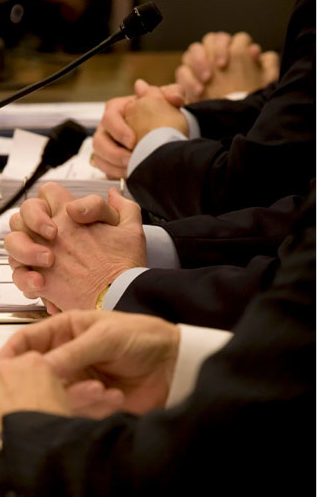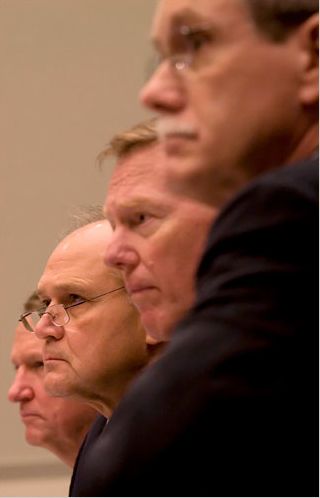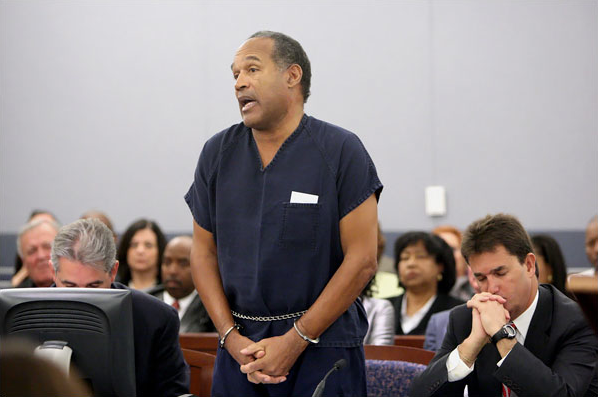When the CEOs of the “big three” U.S. automakers came to Congress last month with hat in hand seeking a financial bailout they were admonished for their greed and arrogance—if not downright insensitivity—symbolized by the fact that they had arrived separately in private corporate jets. When they returned this past week (via hybrid automobiles) they were a bit more contrite, as captured by the photograph below that appeared in a slideshow at the NYT website. They mark a pious stance, very much in keeping with the image of praying hands often associated with the “Act of Contrition”: “I am heartily sorry for having offended Thee … I firmly resolve with the help of Thy grace, to confess my sins, to do penance, and to amend my life.”
The public performance of contrition is a puritanical art form—think of Bill Clinton’s multiple attempts to seek public forgiveness—that demands careful attention to a subtle and nuanced civic republicanism that negotiates the tension between individual humility and the capacity and resolve to do better. One has to be both abject and majestic; totally subject to sovereign forces and yet capable of forging a virtuous path into the wilderness of the future. It is not yet clear that the heads of the auto industry have entirely mastered the role, though the warm color temperature of the above photograph, as well as the one that followed it in the NYT slide show seems to signal some hope.
Cast in a cascading portrait that emphasizes file and not rank, their lips tightly pursed, their eyes riveted in unison upon the source of power and absolution—the duly representative agents of a sovereign “people”—the photograph offers the viewer the statuesque countenance of humble, virtuous men—the elect Captains of Industry—who understand the gravity of their past human failings, and yet nevertheless are eager to take on the responsibility to get the job done right. Robert Nardeli’s eyeglasses are especially notable in this regard. Symbols of human frailty, they sit low on the Chrysler CEO’s nose, allowing him simultaneously to see through them (to the immediate economic problem that sits in front of him) and over them (to the arbiters of the public trust). Surely no less will be needed if the crisis is to be averted and the public’s faith is to be sustained.
But even as the second photograph above inflects the first, framing the act of contrition in the context of a traditional and stylized civic virtue, so too the very next photograph to appear in the slide show seems to inflect the first two photographs.
Here again we see the performance of an act of contrition, but the affect is altogether different: more farce than tragedy. The penitent is immediately recognizable, not just because his body is whole (in contrast to the fragmented bodies portrayed in the first two photographs), but also because of his celebrity and notoriety. Having previously and arrogantly (if ambiguously) admitted to a dastardly crime for which he had been acquitted, here he seeks the mercy of the court by apologizing for his most recent “stupidity” by casting his crime as a “foolish mistake.” The actual performance proved to be unconvincing to the judge, who sentenced the defendant to a minimum of nine years in prison with a 33 year maximum, but it is the photographic performance that bears special significance.
The success of public acts of contrition rely upon a modicum of belief that the “sinner” can rise above his or her human failings—or at the very least that a commitment to live up to the public’s faith will be treated with gravity and responsibility. In this regard, there may be no greater crime than the arrogant disregard of the public trust. And when such arrogance rears its head a second time, the warm tones that give the first two photographs their special cast and resonate with a hopeful future give way to the cold, harsh tones of reality evident in the last photograph. Here, the body, no longer fragmented in terms of the mechanisms of human agency (hands and head) is intact, but more importantly, it also constrained and disciplined by both the instruments of the state (the shackles) and public opprobrium (evidenced by the expressions on the faces of the citizens sitting in the courtroom). Scorned once, the photograph seems to caution, the people look on subsequent acts of contrition with profound skepticism. And, we might add, as well they should.
Photo Credits: Stephen Crowley/NYT; Isaac Bracken/Pool Photo



Something that jumps out at me about the Simpson posture is the shortness of the neck. I’d have to check comparable shots to see if that’s just his physiognomy, but it sure looks like he’s raising his shoulders — shrugging off the significance of his behavior. It also makes his head look big. Neither characteristic helps with a convincing act of contrition.
Susan Abe: Absolutely! You can just imagine him shaking his head saying, I just don’t get it…. what’s the problem here? And, of course, he doesn’t, which completely mitigates any act of contrition. One can also imagine the man sitting to his left with his hands in prayer, his head slightly bowed, his eyes closed as the point of contrast …
Hi there, I thought this might be an appropriate addition to the hands/boots section of the blog… see the picture below the video by John Kolesidis.
http://www.thestar.com/article/551276
all the best for now,
b.b.